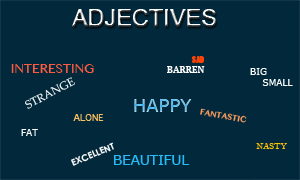Adjectives
Adjectives – Part One
What are adjectives? Adjectives are words that describe nouns. They provide information that helps us to form a clearer picture of an object, person or place. In essence, they are the lifeblood of language. Without adjectives, English would be a barren wasteland, bereft of colour or texture. (‘Barren’ is an adjective.)
Using adjectives can be difficult, as there are guidelines to follow. In English, most adjectives go before the nouns they describe. When an adjective is placed before a noun it is called ‘attributive’. For example, ‘the big dog’ – ‘big’ is an attributive adjective. Other examples: ‘the blue chair’; ‘the sad clown’; ‘the happy student’, and so on.
It is important to note that most attributive adjectives can also be placed after the noun, following the verb ‘to be’: e.g. ‘the dog is big’; ‘the clown is sad’; ‘the student is happy’, etc. When this happens, they are called ‘predicative’ adjectives.
Some adjectives typically go before nouns rather than after them, however. For example: northern, southern, eastern and western. We say ‘northern Europe’, not ‘Europe is northern’; ‘western district’, not ‘district is western’.
There are adjectives that are only used predicatively, too. The adjective ‘alone’ does not go before a noun, e.g. ‘the alone boy’. It is used predicatively, i.e. ‘the boy is alone’. Another example is the adjective ‘ill’. Although this can be used attributively, it is rare to find it in that position: we can say ‘John is an ill man’; however ‘John is ill’ is far more common. We tend to use the synonym ‘sick’ in the attributive position instead (i.e. ‘he’s a sick man’).
Of course it is possible – indeed, at times, desirable – to use more than one adjective to describe a noun. This is where problems can arise for non-native speakers and writers, who lack the intuitive feel for what sounds or looks ‘right’. For example, a student may use the phrase ‘an old fat man’ in their composition. Technically this is acceptable, as it does not break any basic grammatical rules. However use this with a native speaker and they will bristle – feel discomfort – at the ordering of the adjectives. For reasons many native English speakers would not be able to adequately identify or explain, ‘old fat man’ just does not read well.
They would most likely rectify the situation by changing the order of the adjectives thus: ‘a fat old man’. This would make them feel more comfortable with the phrase.
But why? What, exactly, has changed?
The answer: adjectives are separated into categories, each of which has its place in a general order. There is no definitive list that gives the order; different writers promulgate different permutations. However consensus seems to hold that ‘opinion’ adjectives should always precede ‘physical’ adjectives. Consider the following sentences:
A – the ridiculous blue dress
B – the fantastic paper plane
The adjectives ‘ridiculous’ and ‘fantastic’ are opinion-based adjectives. They reflect the thoughts and feelings of the writer, rather than physical actuality. We would never write ‘the blue ridiculous dress’ or ‘the paper fantastic plane, because the ordering would seem incongruous and aberrant.
Next month we will look in more detail at how opinion adjectives can be split into two further categories, and the types of physical adjectives available for us to use.
A. Porter





